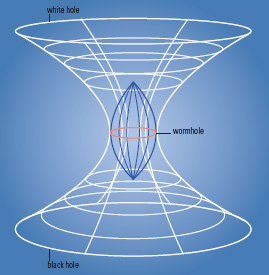String Theory: Difference between revisions
| Line 3: | Line 3: | ||
==Introduction to String Theory== | ==Introduction to String Theory== | ||
String theory is a theoretical framework aimed at addressing the short-comings of Einstein's theory of general relativity and quantum physics - two primary tools for understanding modern physics. String theory is often referred to as the ''theory of everything'' - a just identification given its ability to bridge the gap between gravity and quantum physics. The theory of general relativity and quantum mechanics are the primary, established explanations for the way the universe works on a macroscopic and microscopic scale, respectively. However, these two physical explanations address different ends of the spectrum of matter, in terms of relativistic effects, fundamental forces, and physical properties. String theory provides explanations where modern physics fails. These fields of interest include the early universe, black holes, and atomic nuclei. In order to understand the purpose of the ''theory of everything'' it is vital to have a sound understanding of general relativity's purpose as well as the role of relativistic quantum mechanics - that is, in terms of gravitational effects on matter and the fundamental physics of the universe. General relativity serves an important purpose in determining the gravitational affects on planetary-sized objects and observable particles, for example. However, the "gap" in Einstein's theory lies within its inability to address gravity's effect on elementary particles. General relativity successfully explains macro-scaled particles, given it's ability to incorporate gravitational effects in its theoretical and mathematical foundation. However, the same cannot be said for elementary particles. Accordingly, these elementary particles require relativistic quantum mechanics to explain its physical properties, with the underlying assumption that gravity's affect on this scale is negligible. This is the disconnect between modern physics' primary schools of thought. As a result, the purpose of the string theory is realized in its ability to successfully incorporate gravitational affects, independent of the scale of particles. Thus, the ''theory of everything'' emerged. | String theory is a theoretical framework aimed at addressing the short-comings of Einstein's theory of general relativity and quantum physics - two primary tools for understanding modern physics. String theory is often referred to as the ''theory of everything'' - a just identification given its ability to bridge the gap between gravity and quantum physics. The theory of general relativity and quantum mechanics are the primary, established explanations for the way the universe works on a macroscopic and microscopic scale, respectively. However, these two physical explanations address different ends of the spectrum of matter, in terms of relativistic effects, fundamental forces, and physical properties. String theory provides explanations where modern physics fails. These fields of interest include the early universe, black holes, and atomic nuclei. In order to understand the purpose of the ''theory of everything'' it is vital to have a sound understanding of general relativity's purpose as well as the role of relativistic quantum mechanics - that is, in terms of gravitational effects on matter and the fundamental physics of the universe. General relativity serves an important purpose in determining the gravitational affects on planetary-sized objects and observable particles, for example. However, the "gap" in Einstein's theory lies within its inability to address gravity's effect on elementary particles. General relativity successfully explains macro-scaled particles, given it's ability to incorporate gravitational effects in its theoretical and mathematical foundation. However, the same cannot be said for elementary particles. Accordingly, these elementary particles require relativistic quantum mechanics to explain its physical properties, with the underlying assumption that gravity's affect on this scale is negligible. This is the disconnect between modern physics' primary schools of thought. As a result, the purpose of the string theory is realized in its ability to successfully incorporate gravitational affects, independent of the scale of particles. Thus, the ''theory of everything'' emerged. | ||
''See reference 3.'' | |||
Revision as of 18:03, 3 December 2015
Author: kjoshi39
Introduction to String Theory
String theory is a theoretical framework aimed at addressing the short-comings of Einstein's theory of general relativity and quantum physics - two primary tools for understanding modern physics. String theory is often referred to as the theory of everything - a just identification given its ability to bridge the gap between gravity and quantum physics. The theory of general relativity and quantum mechanics are the primary, established explanations for the way the universe works on a macroscopic and microscopic scale, respectively. However, these two physical explanations address different ends of the spectrum of matter, in terms of relativistic effects, fundamental forces, and physical properties. String theory provides explanations where modern physics fails. These fields of interest include the early universe, black holes, and atomic nuclei. In order to understand the purpose of the theory of everything it is vital to have a sound understanding of general relativity's purpose as well as the role of relativistic quantum mechanics - that is, in terms of gravitational effects on matter and the fundamental physics of the universe. General relativity serves an important purpose in determining the gravitational affects on planetary-sized objects and observable particles, for example. However, the "gap" in Einstein's theory lies within its inability to address gravity's effect on elementary particles. General relativity successfully explains macro-scaled particles, given it's ability to incorporate gravitational effects in its theoretical and mathematical foundation. However, the same cannot be said for elementary particles. Accordingly, these elementary particles require relativistic quantum mechanics to explain its physical properties, with the underlying assumption that gravity's affect on this scale is negligible. This is the disconnect between modern physics' primary schools of thought. As a result, the purpose of the string theory is realized in its ability to successfully incorporate gravitational affects, independent of the scale of particles. Thus, the theory of everything emerged.
See reference 3.
Relevant Mathematical Equations (Bekenstein-Hawking Formula)
- [math]\displaystyle{ S= \frac{c^3kA}{4\hbar G} }[/math]
- inlcude mathematical foundation -- maybe another section (cite pics of equations or insert from wiki page)
The Bekenstein-Hawking formula for entropy of a black hole, shown above, provides a theoretical value for the entropy of a black hole. While this equation provides an expected value that correlates to the entropy of a black hole according to macroscopic features resulting from its microstates, the formula lacks a derivation for a black hole's entropy based on counting microstates on a quantum scale with consideration of gravitational aspects. In 1996, Andrew Strominger and Cumrun Vafa provided a derivation for a black hole's entropy with respect to the number of microstates of a black hole, and in terms of the string theory. The results obtained from these calculations provided solutions matching Berkenstein and Hawking's original formula. Thus, string theory is validated as a mode of quantum gravity.
See reference 1.
Theoretical Foundation
String Theory is founded on the basis that elementary particles are components of strings that are microscopically small - to a degree that technology is not available to visualize this structure. A valid and common depiction of strings lined with elementary particles is a visualization of these same particles lying on a violin string. String theory advocates propose that elementary particles are believed to be in "excited" states due to vibrations in the string. This is a significant due to the bending of spacetime and production of black holes and wormholes - solutions to Einstein's equations which are not explained entirely by quantum physics or general relativity in their own right. On a theoretical basis, string theory provides solutions based on gravity implemented on elementary particles (theory of quantum gravity), a unification of quantum mechanics and Einstein's theory.
- include dimension explanation on wkik and cite another credible source for this here and on the botoom -- pics/diagrams - new external link of YT explaination of string theory(embed?)
- include 10 dimensional information (reference 2)
See reference 2.
Potential Discoveries and Applications
Wormholes
A potential usage of String Theory is to provide the quantum gravitational solutions that Einstein's theory fail to recognize at the center of black holes or worm holes. This inability is due to its lack of consideration quantum forces alongside gravity. The String Theory is integral to discovering wormholes' (derived solutions to Einsteins equations) level of stability. Specifically, String Theory's quantum forces and gravity enables the determination of the radiative affects and stability of these unexplained astrophysical phenomenon. In conclusion, these recently gained understandings of String Theory may ultimately yield answers to questions such as...
1. Given Kerr wormholes and their potential to connect distant points in the universe, is it theoretically feasible to use these solutions for traveling vast lengths through the universe?
See reference 2.
Wormhole Diagram
Connectedness
- How is this topic connected to something that you are interested in? String Theory is a topic that is particularly intriguing due to far-reaching applications that today are widely considered science fiction. (i.e interstellar space travel utilizing wormholes).
- How is it connected to your major? While String Theory does not have any direct application in Mechanical Engineering, a general understanding of the basics yield a profound understanding for the way in which the physical world operates - a vital component in the engineering field.
- Is there an interesting industrial application? Industrial applications of String Theory may not be realized in the near future, but in the long-term an understanding of String Theory could have a profound, yet unforeseen, impact on the world - in a similar revolutionary and unpredicted manner to that of quantum mechanics and the development of modern communication and flow of information.
Scientific Development Timeline
1970: String Theory is proposed to understand the quantum mechanics of oscillating strings.
1976: Supergravity is proposed as a means of explaining the interdependence of gravity and sub-atomic particles' spectrum of excitations - an integral component of String Theory.
1980: Initially perceived to discredit String Theory as a unification of quantum mechanics, classical physics, and particle physics, the inconsistencies of the theory were found to nullify each other when considered as special cases. This is the year that String Theory becomes widely accepted as a potential unifying explanation in the scientific community of the time.
1991-1995: String Theory exploration, in terms of black holes, results in development towards the understanding of the different forms of String Theory, in terms of their relationship.
1996: String Theory provides microscopic understanding of black hole entropy and the nature of black hole quantum physics.
See reference 3.
See also
Are there related topics or categories in this wiki resource for the curious reader to explore? How does this topic fit into that context?
Further reading
Elementary Particles and Particle Physics Theory
External links
References
Reference 1: "SUPERSTRINGS! Black Holes ." Web.physics.ucsb.edu. UCSB, n.d. Web. 03 Dec. 2015. <http://web.physics.ucsb.edu/~strings/superstrings/bholes.htm>.
Reference 2: Kaku, Micho, Dr. "Blackholes, Wormholes and the Tenth Dimension." Mkaku.org. N.p., n.d. Web. 03 Dec. 2015. <http://mkaku.org/home/articles/blackholes-wormholes-and-the-tenth-dimension/>.
Reference 3: Shwarz, Patricia, Dr. "The Official String Theory Web Site." Superstringtheory.com. N.p., n.d. Web. 03 Dec. 2015. <http://www.superstringtheory.com/index.html>.

